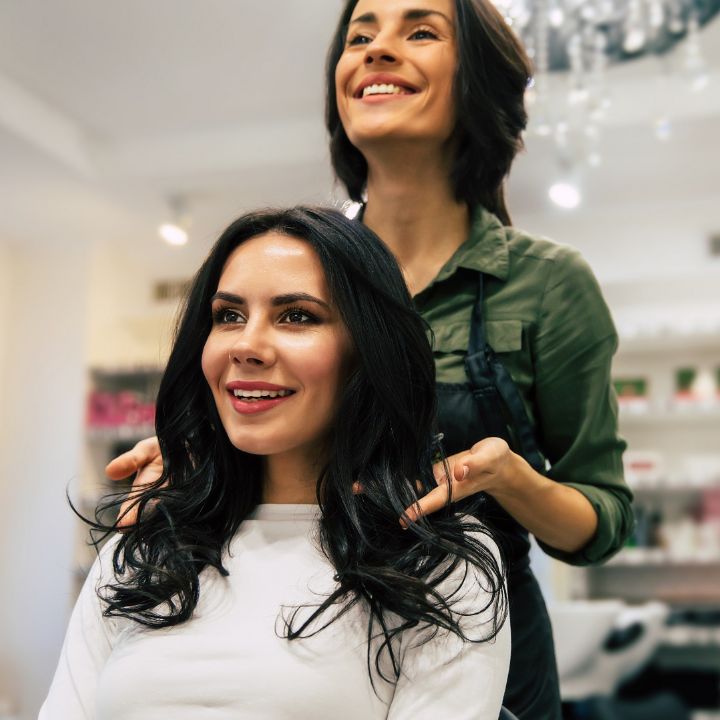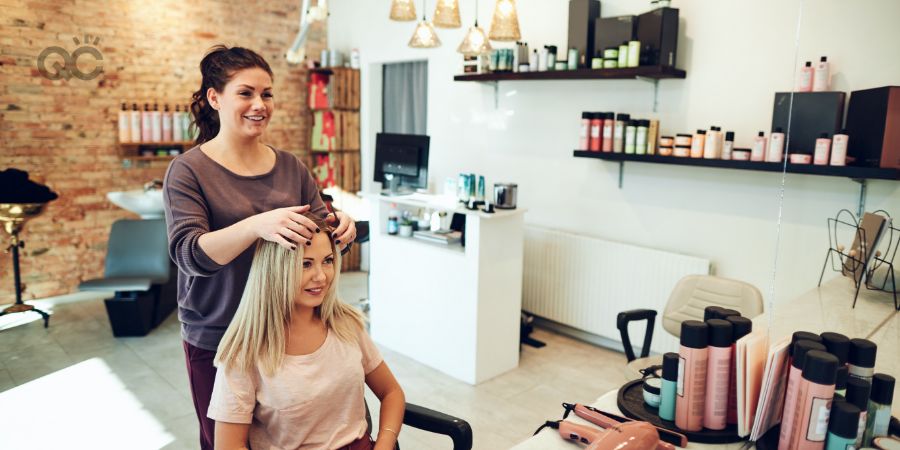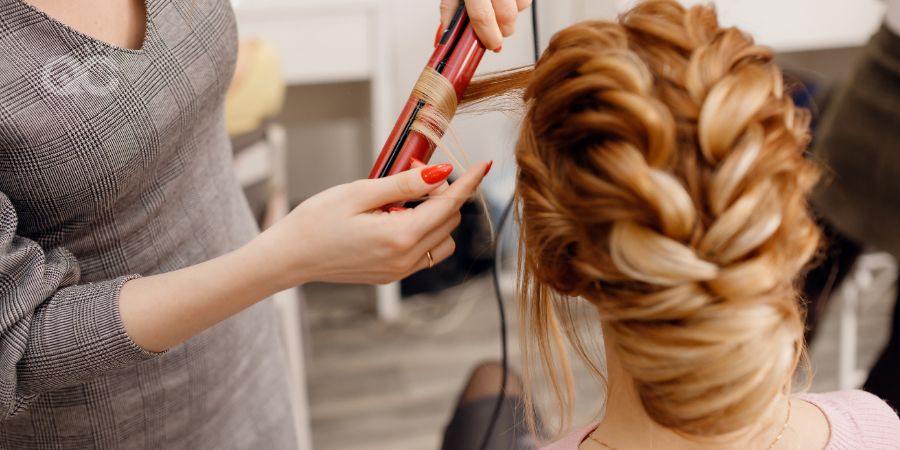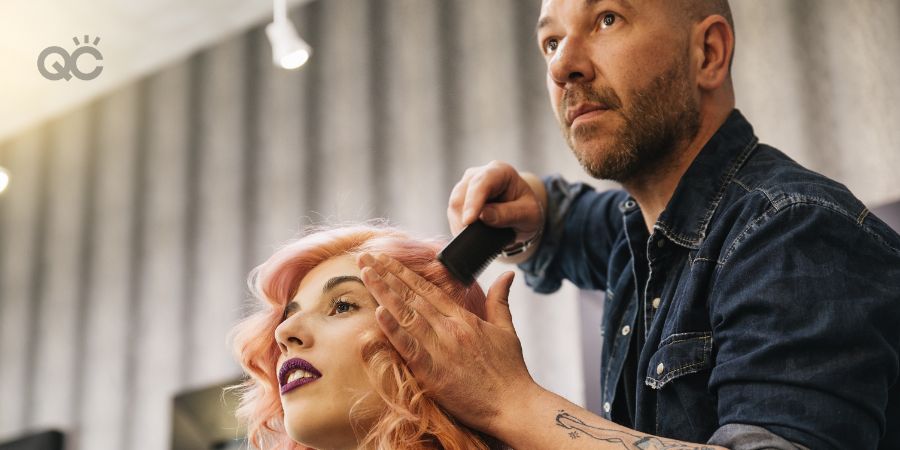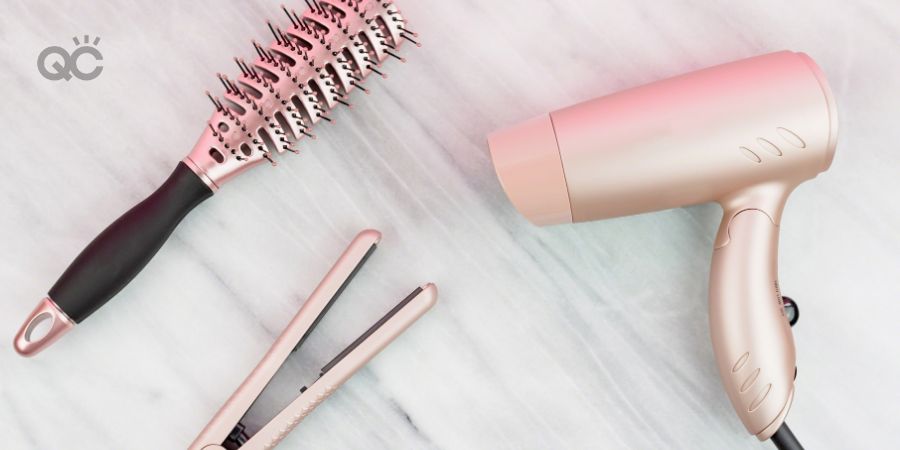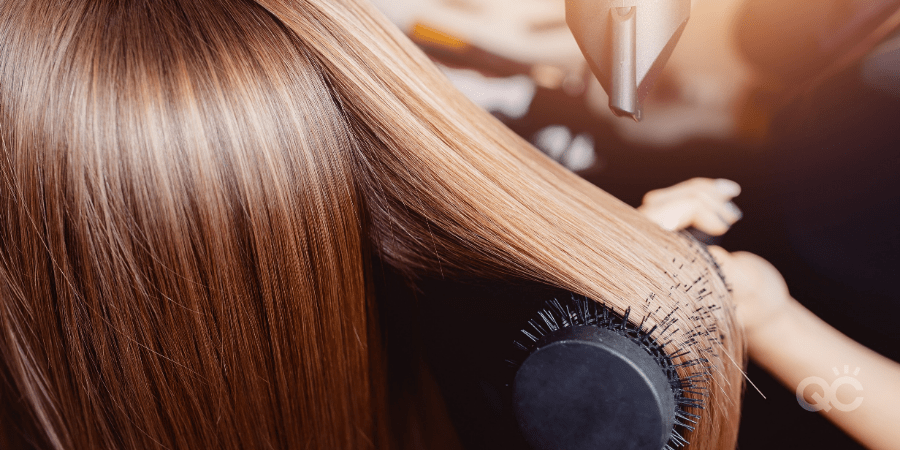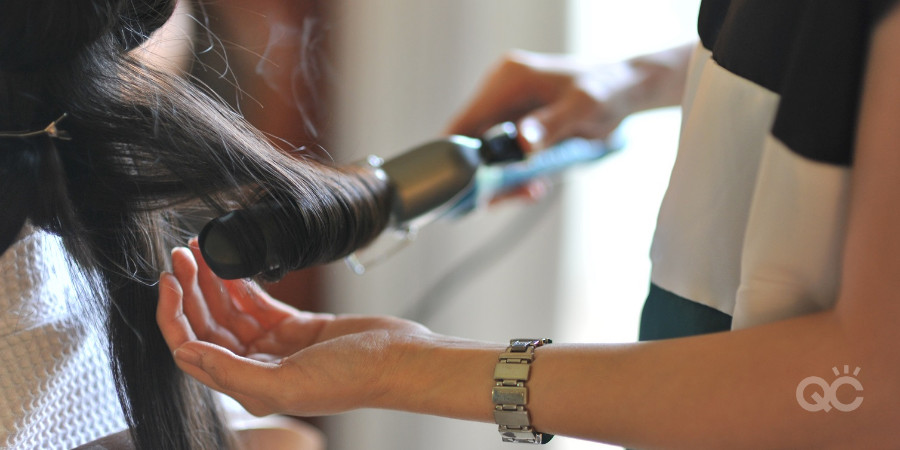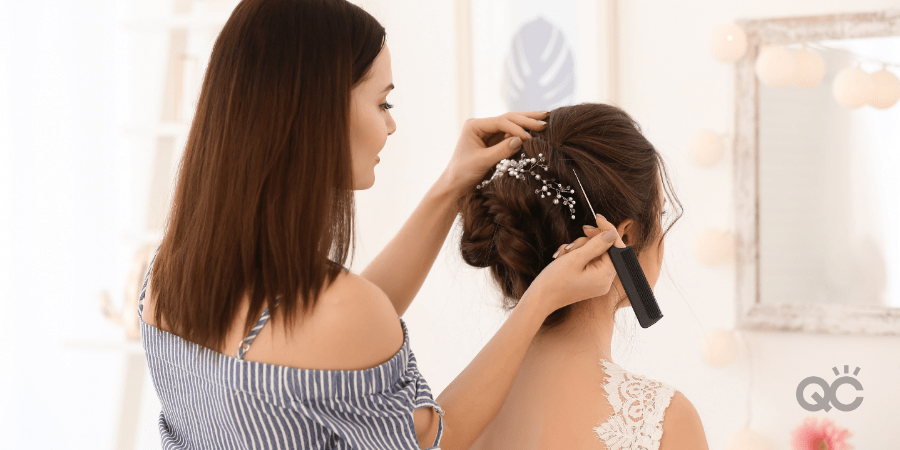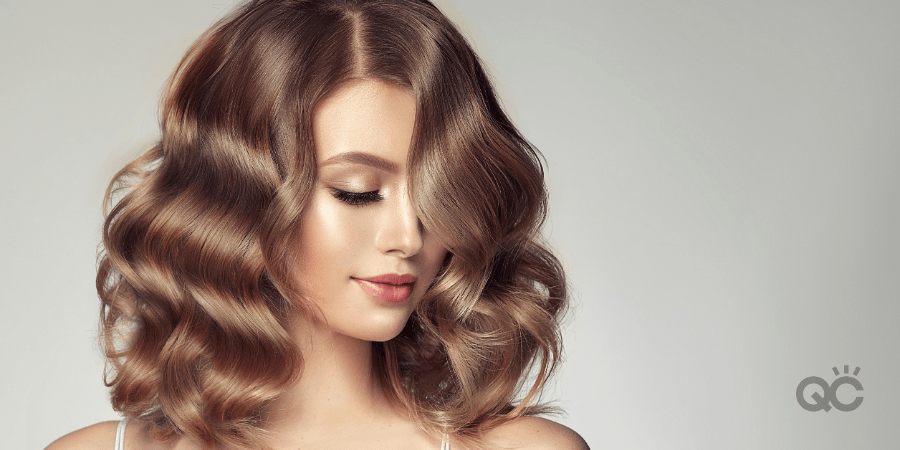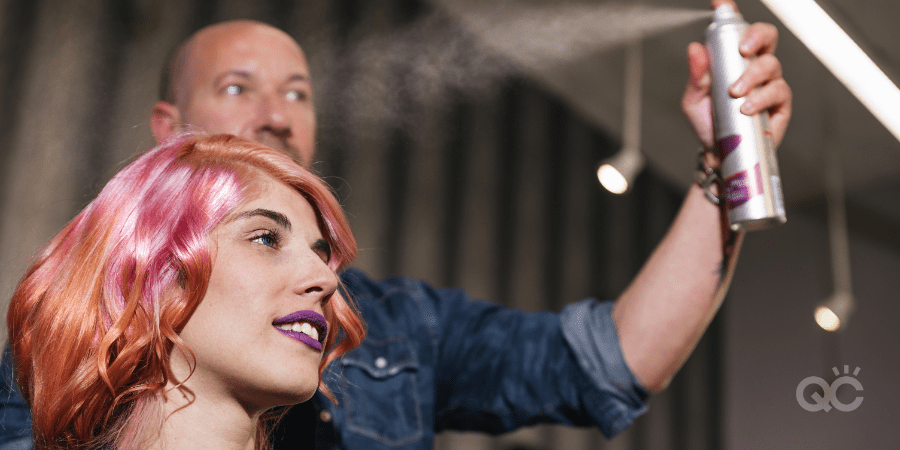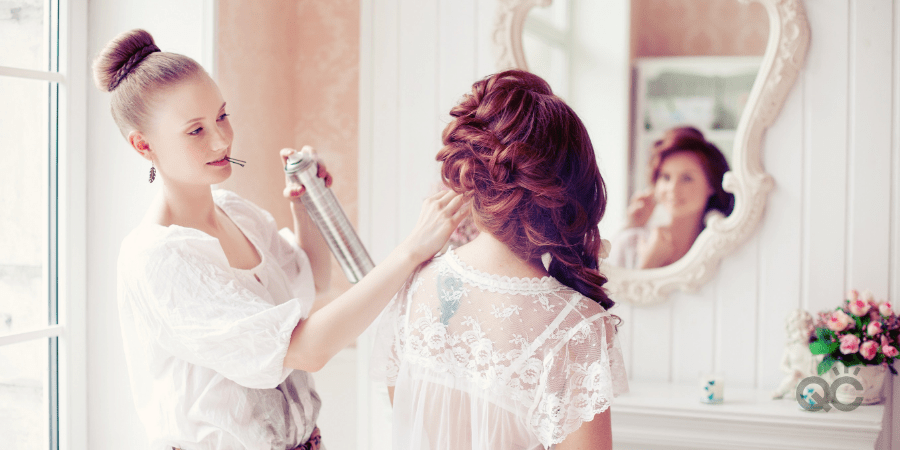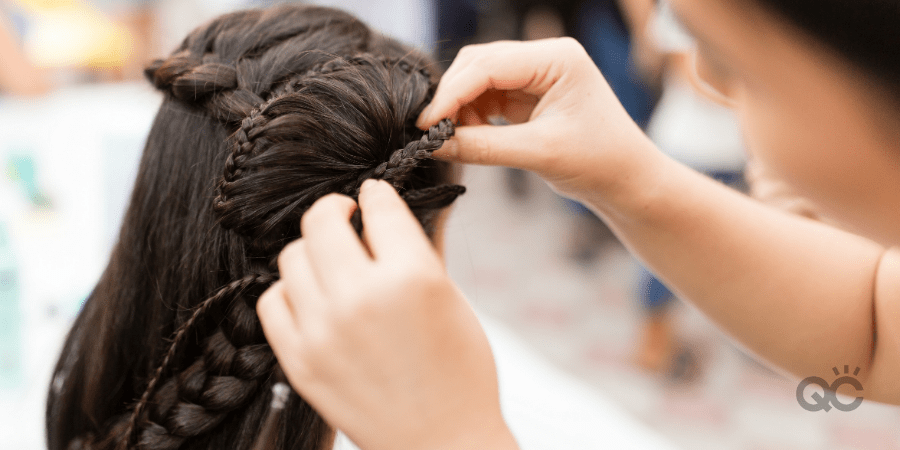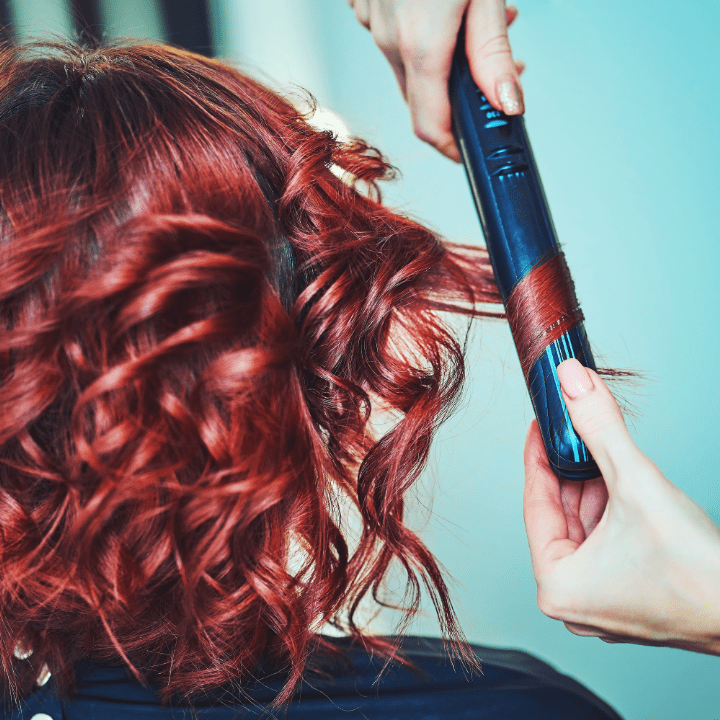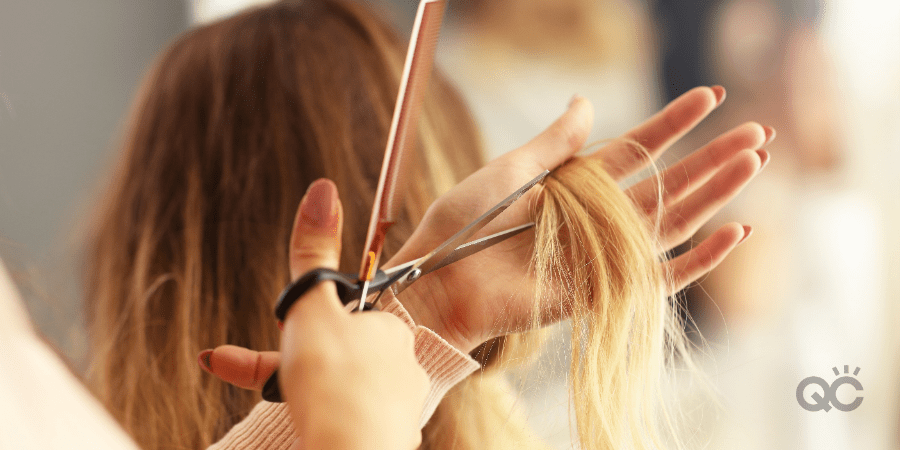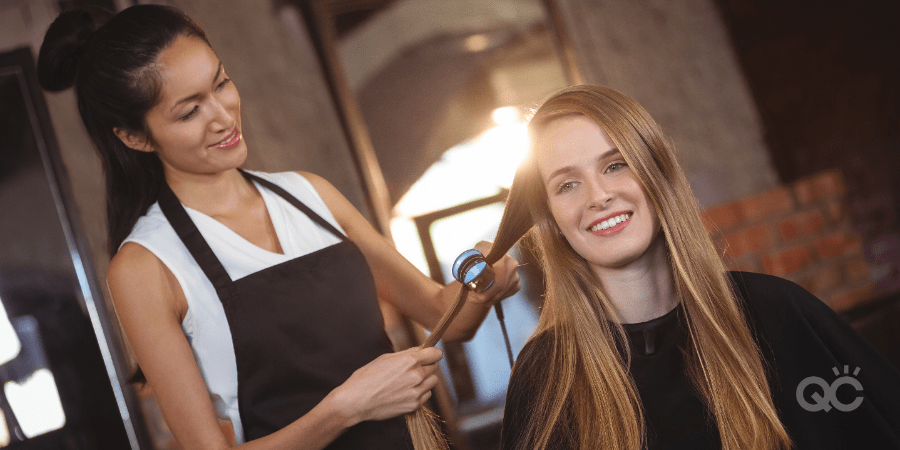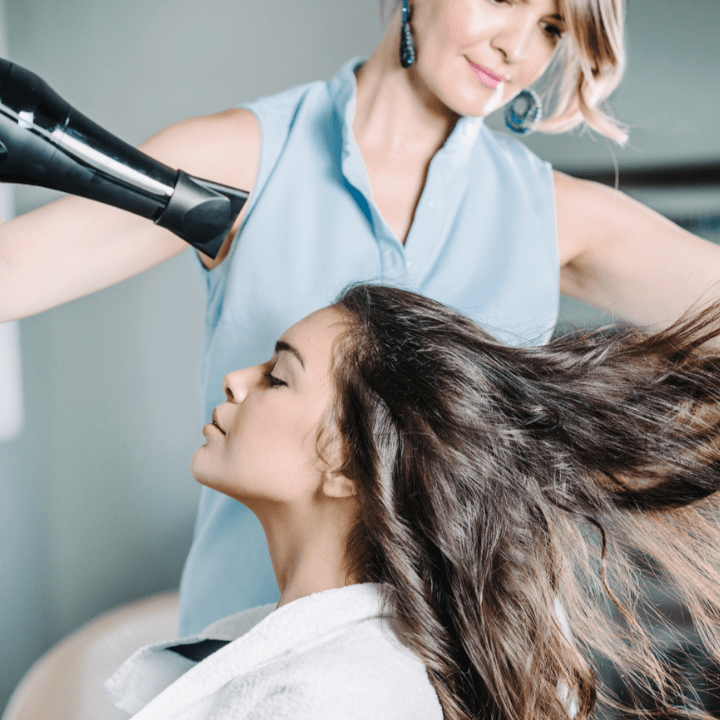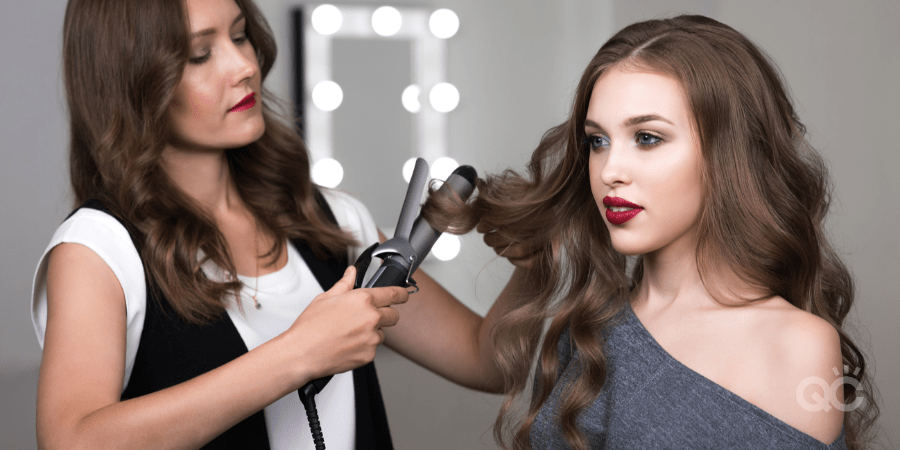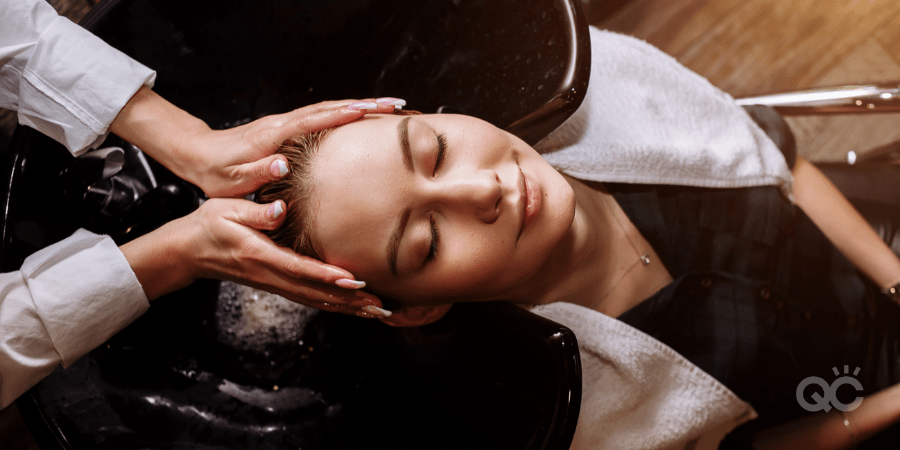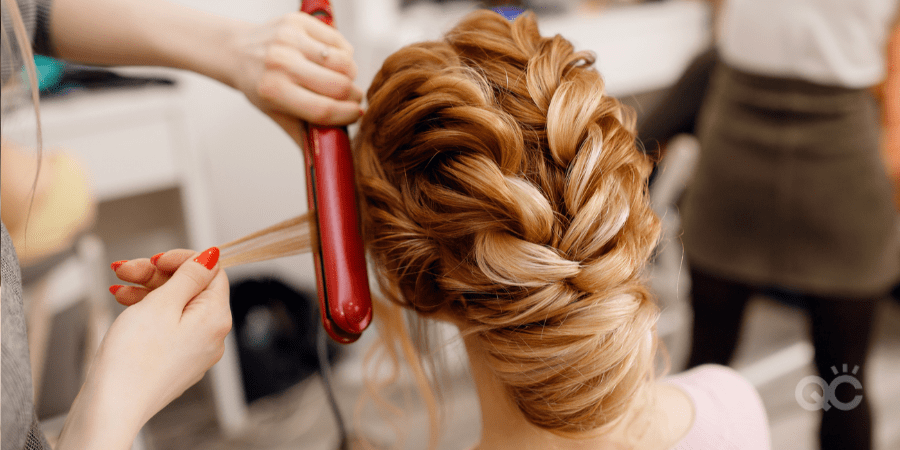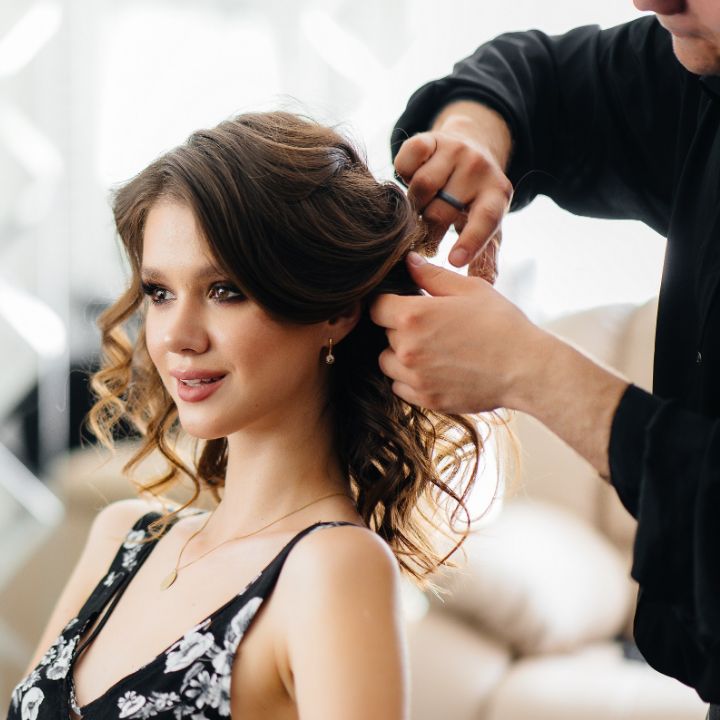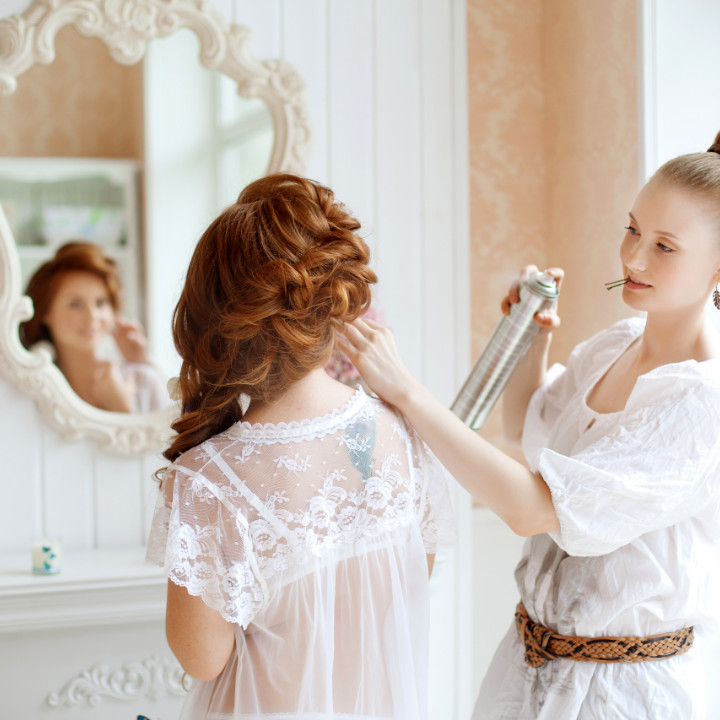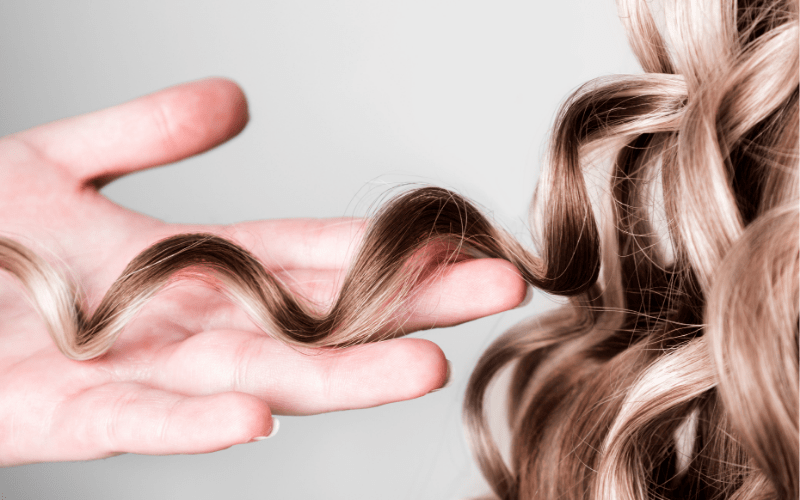
As a hair stylist, you will likely be asked a lot of questions throughout your career. Similarly, if you’re thinking of booking with a hair stylist, you may not know where to start – or what to ask. In this article, we’ll go over (and answer) 40 of the most frequently asked questions for hair stylists! We hope that this information will help those:
- In need of guidance when it comes to choosing a hair stylist;
- Working transparently with clients;
- Looking to ask the right questions.
So, let’s get started!
Common Questions You’ll Hear as a Hair Stylist
First, let’s take a look at the sort of questions you’ll get if you yourself are a professional hair stylist…

Q: “Can you cut and/or dye my hair?”
A: No, as a hair stylist, you are not trained or qualified to make any chemical and/or permanent changes to a client’s hair. This would fall under the job description of a hair dresser, rather than that of a hair stylist. By the same extension, you would not be able to:
- Perm their hair
- Perform any chemical treatments to their hair
- Install permanent hair extensions
Learn more about the similarities and differences between hair stylists vs. hair dressers!
Q: “What hair services do you offer?”
A: As a hair stylist, you are qualified to offer the following services:
- Cutting and styling men’s, women’s, and children’s hair
- Temporary blow-drying
- Applying temporary coloring products like wax sprays or colorful gels
- Creating updos, half updos, down hairstyles, and braiding for special occasions
Q: “How healthy is my hair/scalp?”
A: It’s important to answer this question honestly and accurately. As a hair stylist, you must be able to assess the health of your client’s scalp and hair in order to provide them with the best advice on how to take care of it. In order to do so, you should:
- Perform a full scalp/hair inspection
- Check for signs of damage such as split ends or brittleness
- Inquire about their current hair care routine
Q: “Do you offer any styling tips or advice?”
A: Yes, of course! This is a great way to make sure that the client leaves your salon feeling satisfied with their new look. Make sure to use plenty of product and tell them which products they should use at home in order to keep their hair looking its best.
Q: “How often should I be shampooing and conditioning my hair?”
A: This can vary greatly, depending on individual hair type. However, as a general rule of thumb, most people should shampoo their hair every other day and condition it once or twice a week for best results.
With that in mind, here’s what you can recommend, based on their hair type…
Hair Texture:
- Straight: Shampoo every other day, condition once or twice a week.
- Wavy: Shampoo every 3 days, condition 1-2 times a week.
- Curly: Shampoo every 4 days, condition 2-3 times a week.
- Coily: Shampoo every 5-7 days, condition 3-4 times a week.
Hair Structure:
- Fine: Use a lightweight shampoo and conditioner.
- Medium: Use a mild cleanser and rinse out conditioner.
- Thick: Use a volumizing shampoo and deep conditioner.
Scalp Moisture:
- Dry: Use a nourishing shampoo and conditioner.
- Normal: Use a moisturizing shampoo and conditioner.
- Oily: Use a clarifying shampoo and light conditioner.
Need help identifying your hair type? This chart, courtesy of Function Of Beauty, will point you in the right direction!
Q: “What hair styling tool will I need to use at home to replicate this look?”
A: Once you’ve finished styling the client’s hair, it’s important to provide them with a list of the products used. Plus, you should list any tools they’ll need in order to replicate their look. This could include items such as:
- Curling irons
- Flat irons
- Blow dryers
- Products like texturizing sprays, mousses, and gels, etc.
Q: “My hair is burnt. What should I do?”
A: Unfortunately, this is something that can happen when using too much heat when styling. It’s important to be honest and tell the client that they should avoid further heat styling until their hair has been treated by a professional with the right qualifications for such a task. Professional treatments could include using specialized products such as protein masks or keratin treatments to help repair their damaged hair.
Finally, make sure to emphasize the importance of using a heat protectant prior to any future heat styling, in order to prevent further damage!
Q: “How much do hair stylists make?”
A: Throughout your career, you may get asked this questions by clients who are also thinking of pursuing a job in this field. Because there’s no clear-cut answer to this question, you can let them know that salaries vary and depend on things like:
- Experience
- Qualifications
- Skill set(s)
- Whether they run their own business, are a freelancer, or work for an employer, etc.
Should you want to be a bit more specific, you can always give them a general yearly salary range based on the country you live in:
- United States: Between approx. $20,900 and $68,200 USD annually (Source: Salary Expert).
- Canada: Between approx. $29,000 and $64,000 CAD annually (Source: Glassdoor).
- United Kingdom: Between approx. £23,400 and £39,500 GBP annually (Source: Talent.com).
- New Zealand: Between approx. $19,700 and $66,200 NZD annually (Source: Salary Expert).
- Australia: Between approx. $40,000 and $71,000 AUD annually (Source: Payscale)
“How Much Does a Hair Stylist Make an Hour?”
Again, since this can vary depending on a number of factors, it’s best to provide an average hourly rate (if you really want to get into the nitty gritty details). Depending on the country you live in as a hair stylist, you can make:
- United States: Between approx. $17-$28 USD per hour (Source: Talent.com).
- Canada: Between approx. $15-$23 CAD per hour (Source: Talent.com).
- United Kingdom: Between approx. £7-£11 GBP per hour (Source: Payscale)
- New Zealand: Between approx. $16-$26 NZD per hour (Source: Glassdoor).
- Australia: Between approx. $21-$30 AUD per hour (Source: Payscale).
Q: “How long does it take to become a hair stylist?”
A: It really depends on where you get your training from. Some hair stylists opt to get their credentials from a cosmetology school. This typically takes between 8 months and 2 years, depending on the program you choose.
Other stylists decide to gain experience by working in salons as an apprentice. This route usually takes 3-4 years.
You can also obtain a certificate or diploma through online courses, such as the Hair Styling Essentials Course taught by QC Makeup Academy. Since this program is entirely self-paced and done right from the comfort of home, YOU get to decide when you graduate!
(As a point of reference, if you were to devote just 1-2 hours per week to this QC course, you could earn your internationally-recognized Hair Styling Essentials certificate in as little as 2 short months!)
Want to learn more about QC Makeup Academy’s self-paced, online Hair Styling Essentials Course? Check out the full course curriculum!

Questions to Ask a Hair Stylist
Next, let’s talk about the questions that you – as the client – should ask your hair stylist before booking an actual appointment. Here are a few of the most important ones…
Q: “Do you have any experience with my type of hair?”
A: It’s important for your stylist to be familiar with the type of hair you have. Questions like this will help you gauge how experienced your stylist is. Plus, it can also give you more insight into their overall skill set.
Q: “What are your areas of expertise?”
A: Your hair stylist might specialize in things such as updos, color services, straightening methods, etc. Asking this question can give you a better understanding of what your stylist is capable of doing!
Q: “Do you use professional products?”
A: Ask to see what kind of products they use on clients’ hair, as well as which ones they recommend for your specific hair type. Professional products can make a huge difference in terms of quality and longevity! Not to mention, if a hair stylist is only working with lower-quality products and/or tools, this can be seen as a reflection of the type of work they’d do on your hair.
Q: “Can I see your hair styling portfolio?”
A: Any hair stylist worth your consideration should have a professional portfolio to show you. This is especially the case if that hair stylist has been in the industry for a while!
The purpose of the portfolio is to be able to show you their past work. Ideally, this work should reflect various different styles, techniques, and areas of expertise.
Seeing a hair stylist’s portfolio is important for you to get an idea of their styles and techniques, as well as the results they’re realistically capable of achieving.
Q: “Do you offer consultations or trial services?”
A: It’s always a good idea to ask your hair stylist if they offer consultations prior to actually booking an appointment. This can help you get a better sense of the type of work they do and whether or not their style aligns with yours.
In terms of trial services, this is especially important for anyone that’s looking to book a more complicated service, such as an up-do or color service. A trial run will ensure that you’ll be happy with the results.
Q: “What are your qualifications as a hair stylist?”
A: This is an especially important question to ask if you’re looking for a more experienced or upper-level hair stylist. It’s totally fine to ask what kind of qualifications and credentials they have, as well as where and when they received their training.
The answers to these types of questions can help give you peace of mind that the individual you are booking with is knowledgeable and experienced.
Q: “How long have you been a hair stylist?”
A: This is another important question to ask in order to gauge a hair stylist’s experience level. Generally speaking, the longer someone has been in the industry, the better!
Furthermore, asking this question can also help you determine if they’re up-to-date with the latest hair styling trends and techniques.
Q: “What are your rates?”
A: It’s always a good idea to ask about their pricing before booking an appointment. Most hair stylists will have different rates for various services, so it’s important to make sure that you understand exactly what you’re paying for and why.
Most importantly, don’t be afraid to shop around – price is often a reflection of quality and experience!
Q: “Do you offer any discounts or loyalty programs?”
A: Discounts and loyalty programs can be a great way to save money while still receiving quality services. Ask your hair stylist if they offer any such incentives or programs.
Most salons will have some type of deal that you can take advantage of. So, it’s definitely worth inquiring about!
Q: “Do you have a website?”
A: This is an especially important question if the hair stylist is a freelancer or running their own business. Having a website is essential for any serious hair stylist! After all, it can provide you with valuable information about their services, rates, contact information, and portfolio.
If the hair stylist is running their own business and doesn’t have a professional website, this could be a sign that they’re either new to the industry or not taking their work seriously. Therefore, it’s best to proceed with caution if you’re thinking of booking with them.
PRO TIP: Make sure their website contains these 7 essentials items!
Q: “Can I find you on social media?”
A: This is the kind of questions that’s useful, regardless of whether the hair stylist works independently or for an employer. Here’s why:
- Social media is a great way to stay connected with your hair stylist!
- You can get updates on any special offers they may have!
- You can check out more of their work that may not be included within their portfolio!
Q: “Can you provide references?”
A: A reliable stylist should be able to provide you with references from past clients who have been satisfied with their results. Taking the time to read these reviews can give you a better idea of what to expect from their services.
Having references also adds an additional layer of trustworthiness and credibility, which is always a plus!
Q: “Do I need to come to you or can you travel to me?”
A: If you’re in need of a hair stylist for a special event (such as a wedding), it’s important to clarify if they are willing to travel and what the associated fees may be.
Also, make sure to ask how far in advance you need to book their services if they do need to travel to you!
Q: “Do you offer virtual hair styling services?”
A: You may require virtual services for a number of reasons, such as:
- The hair stylist you’re interested in doesn’t live/work in your area
- The event you need your hair styled for is a destination one
- You’d like to learn first-hand styling techniques from the comfort of your own home, etc.
In any case, virtual hair styling services have become increasingly popular over the past few years. So, it’s worth asking if your hair stylist offers this type of service.
Keep in mind that there may be additional fees associated with virtual styling, so make sure to check on this in advance as well in case you need to include it within your budget!
Q: “Do you have a contract?”
A: Depending on the environment the hair stylist works in, there may or may not be a contract for you to sign. For example, if the stylist is employed by a salon, there likely won’t be one. However, if the hair stylist works as a freelancer or small business owner, it’s quite common to have some type of contract in place.
So, make sure to ask about this beforehand. And if they do provide you with a contract, read it over carefully. This will help ensure that you’re aware of any terms and conditions that may apply!
Q: “What’s your cancellation policy?”
A: It’s always a good idea to ask about the cancellation policy. This will help avoid any potential misunderstandings when it comes time to cancel an appointment. It’ll also help you avoid losing any money in the event that there’s any sort of cancellation fee.
Most salons have a strict 24-hour notice policy. If the hair stylist is a freelancer or business owner, their own policy may be the same – or it may be different. So, make sure you know what their specific rules are beforehand!
Q: “Do I need to tip my hair stylist? If so, how much?”
A: Tipping your hair stylist is a great way to show your appreciation for the quality of their work. And while it’s not mandatory by any means, generally speaking, it’s customary to tip between 15-20%. That said, some people choose to leave more or less depending on their satisfaction with the end result.
Ultimately, it’s up to you as the customer!
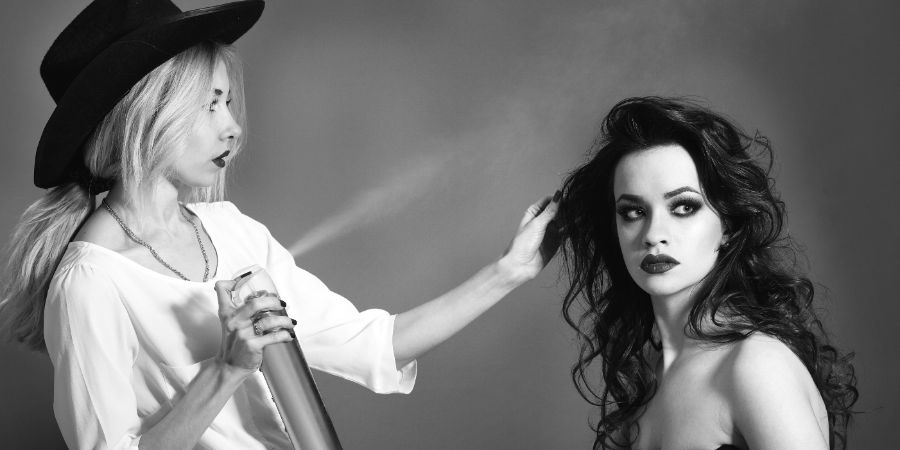
Questions to Ask Your Clients During the Consultation
Finally, let’s circle back and assume that you’re the professional hair stylist. Of course, you’ll want to ensure that the client feels comfortable and safe during the consultation. Moreover, you’ll want to walk away from the consultation with a firm understanding of their needs.
So, here are some essential questions to ask prospective clients during the first consultation…
Not yet a professional hair stylist – but want to be? This comprehensive guide will show you how to become one in as little as 5 easy steps!
Q: “How did you hear about [my business/the salon]?”
A: This question will help you gain insight into any potential referral sources that could be beneficial for your business. Additionally, it may give you an idea of what type of marketing efforts have been the most successful so far!
Q: “Do you know your hair type?”
A: Knowing the client’s hair type is essential, as it will play a major role in determining what products and techniques you’ll use. If they don’t know their hair type, encourage them to bring in photos of themselves with wet and dry hair!
Q: “What are you hoping to achieve with this hairstyle?”
A: Ultimately, you want to make sure that the client walks away with a style they’re happy with. Asking this question will help you gain additional insight so that you can provide them with the best possible outcome.
Q: “Is this for a specific event?”
A: If the client is getting their hair done for a special event, make sure you know what it is. This will provide additional context and help you craft the perfect style to suit the occasion.
Q: “When is this event?”
A: If your client answered “yes” to the previous question, it’s important to get an understanding of when the event is. From there, you craft a strategy for timeliness and ensure that the client has their hair looking great in time for the event!
Q: “What are you looking to get done?”
A: This may seem like a no-brainer, but you obviously can’t do your job as a hair stylist if you don’t know what the client wants – and if you’re capable of providing it to them. So, make sure you get a clear understanding of what they’re looking to achieve. This will ensure that both parties are on the same page and expectations can be met!
Q: “What products do you use on your hair?”
A: It’s always beneficial to have an understanding of the type of hair products the client uses on their hair. From there, you craft a strategy as to what type of products and techniques you’ll use during the hairstyling process!
Q: “Do you have any allergies or sensitivities?”
A: This is a VERY important one! You’ll want to make sure your client doesn’t have any allergies or sensitivities that would cause an adverse reaction. So, make sure you get very clear answers on this one!
Q: “Do you have any hair styling preferences?”
A: Asking this question is essential, as it helps make sure that any preferences the client has are taken into account. For instance, some clients may have a preference for updos, whereas others may prefer to wear their hair down. By asking this question, you can make sure that their hair is styled exactly how they want it to be!
Q: “Do you have any cowlicks?”
A: Cowlicks, or the natural direction that certain hairs grow in, can be a bit of a challenge to work with. This can especially be the case when working with bangs. So, make sure to ask your client if they have any so you can factor it into your styling process.
Q: “Do you have a budget?”
A: In some cases, the client may have a budget in mind for their hair styling session. Knowing this ahead of time will help you plan accordingly and make sure that you won’t be going over their budget!
Now, what happens if a client’s budget doesn’t match with your service rates?
Don’t be afraid to negotiate! It’s a great way to show your client that you understand their needs and wants, and it’ll help ensure that both parties are happy with the outcome.
And if they outright refuse to work with you and pay a fair cost for your services? It’s okay to turn down a potential customer if they’re unwilling to meet a price that you feel is reasonable. Just be sure to do so politely, respectfully, and professionally.
What’s a “Choosing Beggar”? Find out who they are – and why you should avoid working with this type of client!
Q: “How do you like to part your hair?”
A: The best way to get the answer to this question is by asking the client to show you how they typically part their hair. This will give you a better understanding of whether or not their preference is to have their hair parted down the middle, on one side, or a bit more off-center. Once you’ve got a good visual, it’ll be much easier to craft their hairstyle and make sure it’s exactly how they want it!
Q: “Would you also like to get your makeup done?”
A: This is a GREAT question to ask during the initial consultation if you also happen to provide makeup services. Not only will you be able to make sure that your client has their entire look ready for their special occasion – it can also be a great opportunity to upsell and possibly provide additional services.
If they answer “yes” to this question, let them know that you can also provide them with this service at the same time as their hair styling. If you’re able to bundle the services together and give them a discounted rate, let them know this, too!
Interested in adding makeup to your hair styling business? Become a fully trained and globally-recognized Master International Makeup Professional (MIMP) in as little as 8 short weeks with QC Makeup Academy’s online Master Makeup Artistry Course!
Q: “Do you have any reference photos?”
A: If a client has reference photos, this can help give you a better idea of what kind of look they’re going for and make sure that the final style is exactly the way they want it. So, if your client does have any reference photos be sure to ask them to show them to you.
However, approach the reference photos carefully. Sometimes, they can give clients unrealistic expectations. So, take a good look at the style and let them know honestly whether their hair type would produce the same results. If not, let them know how their results may be different, so the client isn’t unpleasantly shocked after all the work is done.

Frequently Asked Questions for Hair Stylists: Final Thoughts
As a hair stylist, it’s important to be prepared for any and all questions that your clients might have. And as a client, being prepared with the right questions to ask will help you get the best results.
Knowing the answers to all the questions listed above will not only ensure that your hair styling experience is a smooth one, but it’ll also make sure that you and your stylist are on the same page and understand each other.
Got any questions or comments to add to the conversation?
Drop them below, as we’re always happy to hear from you!
Thanks for reading! 💕
